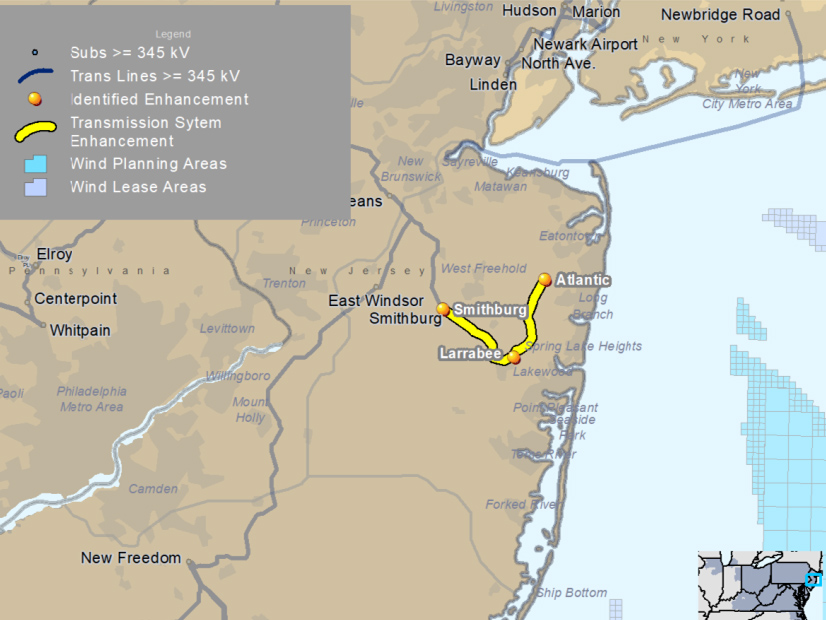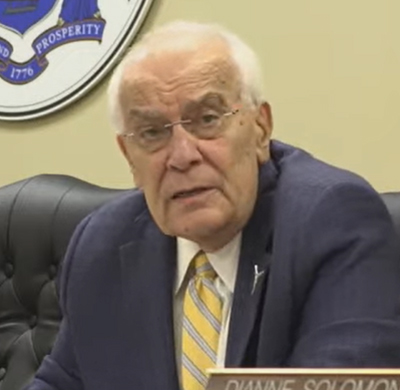
The New Jersey Board of Public Utilities voted unanimously Wednesday to spend $1.07 billion on transmission upgrades to deliver 6,400 MW of offshore wind generation to the PJM grid, saying the projects would minimize costs, environmental impacts and permitting risks (Docket No. QO20100630).
The BPU made its selection from among 80 proposals submitted by 13 developers in response to a solicitation issued by PJM at the BPU’s request under FERC Order 1000’s State Agreement Approach.
The solicitation asked for four categories of transmission upgrade proposals, including Option 2 for new offshore transmission connection facilities — extending the PJM grid into the ocean — and Option 3 for new offshore transmission network facilities. (See PJM Sees Wide Range of Costs in NJ OSW Tx Proposals.)
 Andrea Hart, N.J. Board of Public Utilities | NJ BPU
Andrea Hart, N.J. Board of Public Utilities | NJ BPU
But Andrea Hart, BPU’s senior program manager for offshore wind, said BPU staff and consultants Brattle Group rejected those options as too costly, narrowing its selection to Option 1b proposals for new onshore transmission connection facilities and Option 1a proposals for upgrades to resolve reliability criteria violations resulting from the generation injections.
Hart said most of the Option 2 proposals connected only a single project to each offshore substation, resulting in no reduction in the number of export cables compared with a baseline scenario without coordinated procurement. In addition, transmission-only projects would not qualify for the 30% federal investment tax credit available to generation projects, foregoing as much as $2.2 billion in subsidies. The Option 3 proposals, which were contingent on Option 2, were also rejected. “Staff remains optimistic that the costs of a coordinated transmission will continue to decrease, which could open the door for procurement of option two facilities through a future SAA solicitation,” she said.
In addition to $575 million in necessary Option 1a upgrades, staff selected what it called the Larrabee Tri-Collector Solution, which includes parts of FirstEnergy’s Jersey Central Power and Light’s 1b proposal (NYSE:FE) and pieces of Mid-Atlantic Offshore Development’s Option 2 proposal.
 The Mid-Atlantic Offshore Development proposal will provide routes to three points of interconnection on Jersey Central Power and Light’s transmission system: the 230-kV Larrabee substation, two 500-kV transmission lines to the Smithburg substation, and one 230-kV line to the Atlantic substation. | Mid-Atlantic Offshore Development
The Mid-Atlantic Offshore Development proposal will provide routes to three points of interconnection on Jersey Central Power and Light’s transmission system: the 230-kV Larrabee substation, two 500-kV transmission lines to the Smithburg substation, and one 230-kV line to the Atlantic substation. | Mid-Atlantic Offshore Development
The centerpiece of the $504 million project will be a new substation adjacent to JCP&L’s existing Larrabee substation. Mid-Atlantic Offshore Development, a joint venture of Shell New Energies US (NYSE:SHEL) and EDF Renewables North America (OTCMKTS:ECIFY), will build the AC portion of the new Larrabee Collector Station to accommodate three future HVDC circuits. The project will include sufficient land for the installation of up to four DC converter stations. “This will ensure robust competition is maintained — upholding open-access transmission principles — throughout future OSW solicitations,” the board said.
The collector station will use existing JCP&L rights of way to distribute up to 4,890 MW to three points of interconnection (POI): the Smithburg 500-kV, the Larrabee 230-kV substation and the Atlantic 230-kV.
Although the BPU’s order does not provide a shore crossing solution under the SAA, its order noted that the MAOD proposal identified the National Guard Training Center at Sea Girt as the preferred crossing point.
The board said the Larrabee collector is “an innovative transmission solution, creating a single onshore POI while leveraging existing rights of ways, an outcome that would not have been possible without coordinated planning and a competitive solicitation.”
“The awarded projects also position the state to seek direct federal funding for future expansions of the OSW transmission grid, including the potential to award a full OSW backbone in connection with the board’s future OSW solicitations, and preserves preferable interconnection locations and transmission corridors for future use,” the board said.
Although the MAOD-JCP&L Option 1b solution was intended to connect three 1,200-MW HVDC systems, PJM said the equipment in the AC substation can handle up to 4,530 MW of future injections from DC converter stations.
“PJM’s analysis suggests that this provides an excellent platform for accessing additional headroom on the PJM system with modest additional upgrades in the future,” the BPU said.
The Missing Link
The SAA solicitation was intended to provide sufficient transmission to provide 6,400 MW of OSW capacity, helping the state meet its original goal of 7,500 MW of OSW by 2035. Ocean Wind I, which was awarded offshore wind renewable energy certificates for 1,100 MW in the state’s first OSW solicitation, is not eligible to use the capacity resulting from the SAA.
The BPU acknowledged that the transmission projects it selected under the SAA would not prevent future OSW generators from proposing different landing points or different routes from their landing points to the Larrabee collector.
 BPU Chair Joseph Fiordaliso | NJ BPU
BPU Chair Joseph Fiordaliso | NJ BPU
As a result, the board said it will require a successful bidder in its third OSW solicitation, scheduled for the first quarter of 2023, to “prebuild” a single corridor from the shore crossing to the Larrabee collector, ensuring a single onshore transmission corridor.
In September, Gov. Phil Murphy increased the state’s OSW goal to 11,000 MW by 2040. The board’s order directs staff to begin a second round of coordinated transmission planning to meet the increased goal, potentially including a new SAA solicitation.
Pending approval of the PJM board, the RTO will include the projects selected by the BPU in its Regional Transmission Expansion Plan as baseline public policy projects.
In addition to the Larrabee collector, the BPU approved $575 million in upgrades to existing onshore transmission identified by PJM as necessary to support the OSW injections, including:
- PSE&G’s proposed Brunswick to Deans and Deans subprojects and Windsor to Clarksville subproject: $40.3 million;
- LS Power’s additional Hope Creek-Silver Run 230-kV submarine cable plus upgrade: $61.2 million;
- Atlantic City Electric’s proposal to reconductor the Richmond-Waneeta 230-kV line: $16.9 million;
- Transource’s North Delta A proposal: $109.68 million;
- PPL to reconductor the Gilbert-Springfield 230-kV: $380,000;
- PECO to replace four Peach Bottom 500-kV breakers: $5.6 million; and
- BGE to upgrade one Conastone 230-kV breaker: $1.3 million.
Because the State Agreement Approach requires New Jersey to assume 100% of the costs of the $1.07 billion in spending, the bills of average residential customers will increase by $1.03/month, the BPU said.
The BPU said its selections would save $900 million over the baseline scenario, evidence of the board’s “prudent and careful” approach, BPU Chair Joseph Fiordaliso said.
 BPU Commissioner Dianne Solomon | NJ BPU
BPU Commissioner Dianne Solomon | NJ BPU
But Commissioner Dianne Solomon said she was concerned about the costs of this and future transmission expansions. “I’m sure my fellow commissioners agree we must work with others in our region to oversee and share the costs of the build out of offshore wind,” she said.
The BPU’s order said “it may be beneficial, prior to initiation of the second SAA, to review with other states, both inside and outside the PJM region, the potential for jointly undertaking an offshore wind planning process and incorporating those larger needs into this future SAA. While such a multistate process may present additional complexities, it is also likely to reduce costs to ratepayers by identifying even more robust regional solutions by considering a wider range of public policy needs, and by enabling the sharing of costs with other states who participate in the SAA process.”
Comments
MAOD did not respond to a request for comment. FirstEnergy spokesperson Chris Hoenig called the award “a landmark development opportunity in new, regulated transmission assets.”
PJM CEO Manu Asthana called the BPU’s action “an important milestone in the development of offshore wind in the U.S.”
“We see the State Agreement Approach as a model for how states can leverage PJM’s processes to advance their policy goals,” he added.


